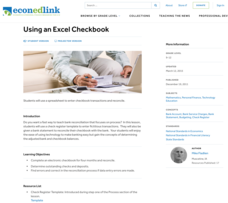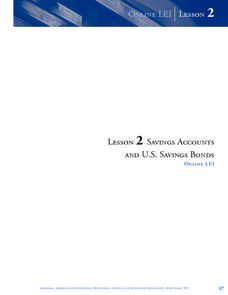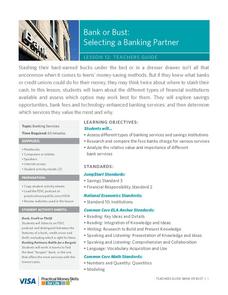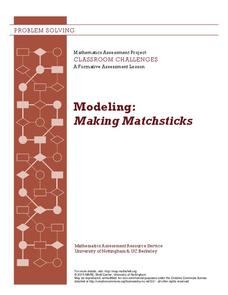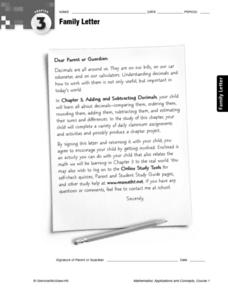Council for Economic Education
Using an Excel Checkbook
High school is the time that many scholars get their first jobs. Help young entrepreneurs apply economic principles to crucial skills for their new jobs and for functioning in society in general. They use Excel to balance a checkbook by...
Curated OER
Accounting - Analyzing Transactions to Debit/Credit Parts
Students are introduced to how transactions are analyzed with debits and credits. In groups, they complete a T-chart in which the account increases with credits and decreases with debits. To end the lesson, they analyze the various...
Curated OER
Buying New Stuff
Young spenders take a look at the best ways to save and spend money. This type of financial education is lacking in schools, so implementing this instructional activity would be of great value to your students. Things like bank checking...
Visa
Make It Happen: Saving for a Rainy Day
Every little penny counts, especially when it comes to saving for emergencies or long-term goals. Pupils evaluate different saving and investment strategies, such as a CD or money market account, through worksheets and by...
Curated OER
Accounting - Debits and Credits (Senior, other) the accounting equation as:
Twelfth graders explore accounting debits and credits through accounting equations.
Curated OER
Lesson 2: Savings Accounts and U.S. Savings Bonds
Students explore the importance of savings accounts and U.S. Savings Bonds. They study the concept of simple interest through a math activity.
Curated OER
Checking Account
In this withdrawing money from a checking account worksheet, learners listen as the teacher reads a passage on why Mr. Nguyen is withdrawing $50 from his checking account.
Curated OER
Show Me The Money!
Students select which bank would best meet their needs. In this lesson plan on personal banking, students write a summary stating which bank and bank accounts best suit their own needs.
Bowland
Cats and Kittens
Can a cat have 2,000 descendants in 18 months? To determine if this claim is realistic, individuals must take different pieces of information into account when justifying their responses.
Bowland
Fish Dish
Minimize the time it takes to create a fish dish. Scholars use their knowledge of time to devise an order that accounts for different constraints. Considering jobs that can be done in parallel is essential to solving the problem.
Bowland
Fruit Pies
Scholars use formulas for the area of a circle and the area of a rectangle to determine the number of pies a baker can make from a particular area of dough. They must also take into account rolling the remaining dough into a new sheet.
Visa
Nothing But Net: Understanding Your Take Home Pay
Introduce your young adults to the important understanding that the money they receive from their paychecks is a net amount as a result of deductions from taxes. Other topics covered include federal, state, Medicare and social...
Visa
Bank or Bust: Selecting a Banking Partner
Why shouldn't we just save all our money in our mattress? Couldn't our money disappear? Pupils discover the benefits of utilizing banks and credit unions for saving money, as well as how to evaluate different types of...
PricewaterhouseCoopers
Saving and Investing: Building Wealth for Financially-Secure Futures
While spending is fun, saving for a retirement is the future. Young adults learn about the importance of saving and different opportunities to do so during their adulthood.
PwC Financial Literacy
Planning and Money Management: Spending and Saving
Financial literacy is such an important, and often-overlooked, skill to teach our young people. Here is a terrific lesson which has pupils explore how to come up with a personal budget. They consider income, saving, taxes, and their...
PricewaterhouseCoopers
Planning and Money Management: Financial Plan
More planning goes into a budget than a high schooler thinks. Here, they learn about the expected expenses and incomes, along with outside factors such as natural disasters. Learners prepare their own budget and adjust it based on...
Curated OER
Bright Ideas for Bringing up Smart Savers
Students explore the concept of saving money. In this saving money lesson, students read an article about saving money. Students discuss ways to save money and what makes it difficult to save money. Students compare prices of products.
Curated OER
Short-Term and Long-Term Savings Goals
Fifth graders discover how saving money can apply to their lives. In this personal finance instructional activity, 5th graders use the book The Leaves in October, as a conversation starter on income, savings and setting goals. Students...
Mathematics Assessment Project
Modeling: Making Matchsticks
Math: The only subject where the solution to a problem is seven million matches. Young scholars first complete an assessment task estimating the number of matches they can make from a tree of given dimensions. They then evaluate provided...
Curated OER
Family Activity: Adding and Subtracting Decimals
In this math worksheet, students work at home with a family member to add and subtract decimals in a sample check register. Students add deposits, subtract withdrawals and determine the balance of the account.
Curated OER
Calculating Interest
Young scholars solve interest problems for bank accounts and loans to gain real life experience. They also review newspapers and find a car they wish to purchase then are given a rate and time of loan.
Curated OER
Savings and Earnings
Fifth graders complete several activities to learn about earning, budgeting, and saving money. In this saving money lesson, 5th graders read a book about saving money and complete a 'Savings and Earnings' worksheet. Students work in...
Mt. San Antonio Collage
Quadratic Equations and Their Applications
Show high schoolers there is more to quadratic functions than just formulas and parabolas. Connect the math to realistic application problems with a resource that has learners consider such situations as a ball hit in the air, the...
CCSS Math Activities
Smarter Balanced Sample Items: 7th Grade Math – Claim 2
To solve or not to solve that is the problem. A slide presentation of 17 items show different ways that Smarter Balanced assesses Claim 2, problem solving. The items span from sixth and seventh grade concepts to highlight the...
